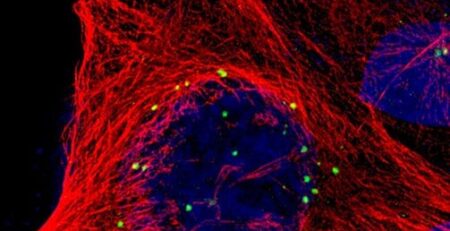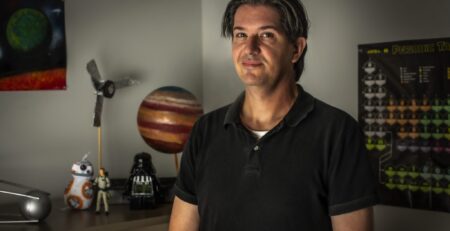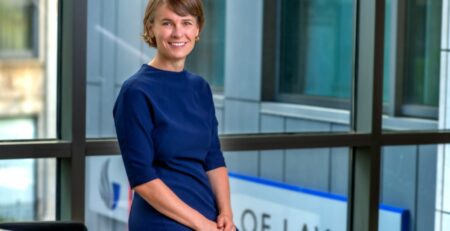Full STEAM Ahead
Full
STEAM
Ahead
Written by Jill Neimark
 s it possible for students who want to learn challenging math and science concepts to gain a deeper understanding by studying painting? Can a choreographer help teach students complicated concepts about neuroscience or biology?
s it possible for students who want to learn challenging math and science concepts to gain a deeper understanding by studying painting? Can a choreographer help teach students complicated concepts about neuroscience or biology?
Professor Michael White, an architect and interior designer who is interim director of Georgia State’s Ernest G. Welch School of Art & Design, says the addition of arts can transform learning in just that way. He is part of the team influencing the new curriculum for Atlanta’s innovative Charles R. Drew Charter School, an institution that has embraced an expanding approach to learning known as STEAM.
Many are familiar with science, technology, engineering and math (STEM) education, but STEAM takes learning a step further by incorporating the arts.
Drew Charter was already embracing this approach and was STEAM-certified by the state for both its elementary and middle schools. When it applied for two grants to help prepare and train its high school teachers in STEAM a few years ago, the school reached out to Georgia State, which is not only a hub of arts and culture, but also a neighbor. The resulting progress has had a ripple effect well beyond the walls of both institutions.
“We want to train students to be more creative in terms of designing experiments. For instance, traditional students in math and science aren’t eager to embrace failure,” White says. “But in the arts, it’s exactly what we do, and our failures tend to be our bigger successes as things happen that we didn’t expect, which can lead to new discoveries and new perspectives.”
To start, Courtney Bryant, director of fine arts and STEAM at Drew, reached out to White to help develop a training curriculum for teachers. White says building sessions and instruction for the grants was like second nature to him, since architecture is already interdisciplinary, drawing on “poetry, literature, painting, art, culture and science, such as moving air, heat and water.”
A professor of art education at Georgia State’s School of Art & Design, Kevin Hsieh, helped steer the STEAM-centric grants. Hsieh has presented internationally on STEAM-collaborative teaching and learning, and has worked closely with university professors to help modify their content delivery to present their material to schoolteachers in an accessible way. He brought this same skillset and mindset to the partnership with Drew.
As part of the work, the research team brought in experts from Georgia State to present a host of workshops to a cohort of teachers, giving them a basic grounding in art history, vocabulary and methodology. Many who have not had training in the arts may not automatically see a connection between art and other subjects, says Melanie Davenport, a Georgia State art education professor who presented numerous workshops. “But, for instance, if you talk about puppets, you realize that cultures all over the world have used puppetry, and there are practical applications for teaching about global cultures and art.”
Looking at how puppets are built also shows students engineering and design techniques along with subjects like anatomy.
“We wanted teachers to walk away with practical applications for integrating art with their discipline,” Davenport says.
In addition to encouraging teachers and students to think across disciplines, STEAM also invites them to think differently in general. White says bringing the arts into technology often leads to new insights and solutions.
“Science students are often trained to come to the table with a hypothesis and an experiment, and if it doesn’t work out, they feel like they hit a brick wall. This type of learning allows them to approach the problem from a fresh perspective,” he says.
This was borne out in a 2019 study by Hsieh and colleagues, published in the International Journal of Arts Education. The study showed the power of five-week interactive STEAM courses. Ninth-grade Drew students designed and constructed “hat” lanterns with LED lights and moveable parts that connected geography, art education, math, physics and the visual arts. Teachers from multiple disciplines joined in. If a student hit a design snag, they would pause and redesign their lantern.
The program leaders say the grant-sponsored work with the educators at Drew was especially rewarding because it allowed Georgia State access to the greater community of teachers. Drew leads professional development opportunities for other schools and had selected three schools across Georgia to join in the Georgia State training sessions —Atlanta’s Luther J. Price Middle, Hampton Elementary School and Valdosta’s Pine Grove Middle School in south Georgia. During the project, Georgia State was able to give hands-on arts education and training to approximately 30 teachers from all four schools.
“Our partner schools don’t have an institution like Georgia State in their backyard,” explains Bryant. “Not only were all these teachers paid stipends for training time, they had access to the materials and resources that were part of our grant.”
Georgia State participated in two “STEAM on Tap” field trips with the teachers before the COVID-19 pandemic struck — one to Savannah and one to Cleveland, Ohio. The group visited industries, schools, art studios and medical and science centers together. “It fostered intimacy,” Bryant says. “They were learning together, but also talking while eating lunch or on the bus, imagining how they would bring new ideas into their classrooms.”
A web of interaction was formed.
To start, Courtney Bryant, director of fine arts and STEAM at Drew, reached out to White to help develop a training curriculum for teachers. White says building sessions and instruction for the grants was like second nature to him, since architecture is already interdisciplinary, drawing on “poetry, literature, painting, art, culture and science, such as moving air, heat and water.”
A professor of art education at Georgia State’s School of Art & Design, Kevin Hsieh, helped steer the STEAM-centric grants. Hsieh has presented internationally on STEAM-collaborative teaching and learning, and has worked closely with university professors to help modify their content delivery to present their material to schoolteachers in an accessible way. He brought this same skillset and mindset to the partnership with Drew.
As part of the work, the research team brought in experts from Georgia State to present a host of workshops to a cohort of teachers, giving them a basic grounding in art history, vocabulary and methodology. Many who have not had training in the arts may not automatically see a connection between art and other subjects, says Melanie Davenport, a Georgia State art education professor who presented numerous workshops. “But, for instance, if you talk about puppets, you realize that cultures all over the world have used puppetry, and there are practical applications for teaching about global cultures and art.”
Looking at how puppets are built also shows students engineering and design techniques along with subjects like anatomy.
“We wanted teachers to walk away with practical applications for integrating art with their discipline,” Davenport says.
In addition to encouraging teachers and students to think across disciplines, STEAM also invites them to think differently in general. White says bringing the arts into technology often leads to new insights and solutions.
“Science students are often trained to come to the table with a hypothesis and an experiment, and if it doesn’t work out, they feel like they hit a brick wall. This type of learning allows them to approach the problem from a fresh perspective,” he says.
This was borne out in a 2019 study by Hsieh and colleagues, published in the International Journal of Arts Education. The study showed the power of five-week interactive STEAM courses. Ninth-grade Drew students designed and constructed “hat” lanterns with LED lights and moveable parts that connected geography, art education, math, physics and the visual arts. Teachers from multiple disciplines joined in. If a student hit a design snag, they would pause and redesign their lantern.
The program leaders say the grant-sponsored work with the educators at Drew was especially rewarding because it allowed Georgia State access to the greater community of teachers. Drew leads professional development opportunities for other schools and had selected three schools across Georgia to join in the Georgia State training sessions —Atlanta’s Luther J. Price Middle, Hampton Elementary School and Valdosta’s Pine Grove Middle School in south Georgia. During the project, Georgia State was able to give hands-on arts education and training to approximately 30 teachers from all four schools.
“Our partner schools don’t have an institution like Georgia State in their backyard,” explains Bryant. “Not only were all these teachers paid stipends for training time, they had access to the materials and resources that were part of our grant.”
Georgia State participated in two “STEAM on Tap” field trips with the teachers before the COVID-19 pandemic struck — one to Savannah and one to Cleveland, Ohio. The group visited industries, schools, art studios and medical and science centers together. “It fostered intimacy,” Bryant says. “They were learning together, but also talking while eating lunch or on the bus, imagining how they would bring new ideas into their classrooms.”
A web of interaction was formed.
Because the schools were geographically separate, Georgia State assisted with transitioning courses and development modules to an online or video format through its Center for Excellence in Teaching, Learning and Online Education (CETLOE). “We had to work with a setup of multiple cameras — one for me to talk, one so you saw what my hands were doing. That was kind of the difficult part,” Davenport says. However, this came in handy when the COVID-19 pandemic transformed the world, because the groundwork for virtual training had already been laid. It also helped spread STEAM education throughout the state. Since this work began, one of the schools, Hampton Elementary, has received STEAM certification from Cognia, a national accreditation organization.
One might wonder, does STEAM-centric education really make a difference? A look at Drew’s annual reports since adopting a STEAM-centric approach suggests the answer is a resounding yes.
Drew students already demonstrate superior academic performance across every discipline, surpassing national and state performance benchmarks. In addition to improved academic performance across all subjects, Bryant says there have been many rich and creative cross-discipline student and teacher collaborations.
Science and art teachers collaborated with students on rendering virtual crime scenes with an augmented reality iPad app. In another collaboration, a 10th-grade faculty team worked with students to create a giant mural based on Picasso’s famous painting, “Guernica.”
“They studied the Spanish revolution, nuclear fission and fusion, war as it related to Spain then and Ukraine now, and art,” Bryant says.
The painting had removable puzzle pieces embedded with graphics that functioned like QR codes linked to videos that went to artist statements, with students talking about their puzzle piece.
“These kinds of collaborations allow kids to express their feelings about the world they’re living in now,” Bryant says.
“It’s astounding what we’re seeing,” concludes White. “Teachers are converts to this approach, and now we see them engaging each other across disciplines. Our goal is to support our community across the state, and this was a perfect opportunity. We did what we do every day at Georgia State, but made it accessible to the broader community.”
Photos courtesy of Kevin Hsieh












Leave a Reply